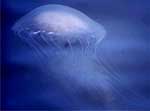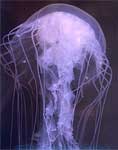 | Taking the Sting Out of Jellyfish Stings |
 | Taking the Sting Out of Jellyfish Stings |
|
By Ellen Kuwana Neuroscience for Kids Staff Writer June 25, 2004
A study led by researchers at Stanford University compared sunscreen to a cream made in Israel called Safe Sea. Safe Sea is an over-the-counter cream that contains sunscreen and ingredients that are supposed to make jellyfish stings less painful.
Experimental DesignTwenty-four volunteers agreed to have their arms stung by either stinging nettles or the more painful box jelly (see jellyfish information in box at right). On each test subject, one arm was covered in sunscreen and the other arm was covered in the sting-inhibitor cream. Next, wet jellyfish tentacles were placed on each arm for up to a minute. Dermatologists (skin doctors) then examined the subjects' arms every 15 minutes for two hours. The dermatologists did not know which arm had been treated with the sting-inhibitor cream. They noted how red the stings were, and recorded how much pain each subject reported.
Sea Nettle Test ResultsTwelve subjects were stung by the sea nettles. For the arm which had sunscreen only, all 12 of the test subjects reported discomfort and all had swelling and redness from the stings. On the arm that had the sting-inhibitor cream, two of the 12 test subjects reported "mild discomfort," and none had redness or swelling.
Box Jelly Test ResultsFor the 12 who went arm-to-tentacle with the fiercer box jelly, the arm with the sting-inhibitor cream fared better. For the arm that had suncreen only, 10 out of 12 test subjects reported discomfort and nine of the 12 showed swelling and redness from the stings. For the arm that had the sting-inhibitor cream, three out of the 12 reported discomfort and only one showed the redness and swelling of a sting.Although the cream was not 100% effective, it did offer some degree of protection. The researchers conclude that Safe Sea does reduce the "frequency and severity" of the stings. The next questions that need to be answered are how it performs in the open water (i.e., the ocean) and how often it should be reapplied. |
Did you know? | That's a fast sting! The box jelly stings with acceleration of up to 40,000 times the force of gravity. The toxin enters the skin within a fraction of second, making the jellyfish sting one of the fastest mechanical events observed in nature. (Source: Wilderness and Environmental Medicine, 15, 102-108, 2004.) |
 Neuroscience for Kids does not
endorse any specific products. The research mentioned in this article was
funded in part by the makers of SafeSea. One of the authors of the
research study (see below) used the product five years ago. He is a
researcher at Stanford University and is a consultant to the company that
makes SafeSea. Neuroscience for Kids does not
endorse any specific products. The research mentioned in this article was
funded in part by the makers of SafeSea. One of the authors of the
research study (see below) used the product five years ago. He is a
researcher at Stanford University and is a consultant to the company that
makes SafeSea.References and Further Information:
|
| GO TO: | Neuroscience In The News | Explore the Nervous System | Table of Contents |
![[email]](./gif/menue.gif) Send E-mail |
 Fill out survey |
 Get Newsletter |
/tr>